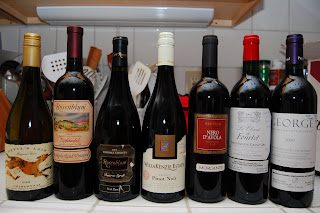The French Laundry. Easily one of the top five restaurants in California and arguably the best in all of the state. They fill up instantly two months in advance. Merely mentioning that you will be eating there gets you a knowing nod. But enough about their food.
Let's talk about their real strength, namely their
wine list. And its ability to make you feel unqualified and well just completely out of your league. For starters it is 100 pages. And because it is a wine list, it only lists wine. For 100 pages. Did I mention that? Their Bordeaux section alone is longer than most high-end wine lists in their entirety.
How "good" is this list? Wine Spectator bestows their highest level of achievement on their list, which only 8 or so places in the US get. This means they have the best wines on the planet and a lot of them to boot.
And of course, one of the truest, crusty definitions of goodness in the sophisticated wine world is oldness. Young is so unrefined. Old is good. Really old as in older than you is great. Back to the list. Those new world world wines don't necessarily age well, and besides many of them weren't even produced before 1985. But we do have some
Beaulieu Calif Cabs from the 1970's and even the late 60's. That's nearly 40 years old. Nice. But for the real goods, take a quick trip to the Europe section. A couple of
Barolos from the 60's. Solid. And Spain gets a few 1960's and a 1947
Rioja. Sweet. The French Burgundies strut their stuff with some 1970's, 1960's and even a couple of 1950's. And then on page 77, we find some 1940's and a 1931
Pommard. That wine had a driver's license before I was even ... er,
ok my point has been made. And finally the Bordeaux, with more than a few 1940's. And two 1929's! Oh my lord.
The region choices say a lot. For the reds, France is extremely well covered at 26 pages. Italy gets 4, Spain 2, Australia 1 and a half. Washington gets 1 and the local state gets 15 pages with superb wines from all over especially
Napa Cabernets. Every region of the world is listed including Greece. Well, except Argentina and Chile. So the list isn't completely authoritative.
Hmmm.
But we've saved the best for last. Price. How better to make you feel outclassed than your inability to pay for even a single sip from a bottle. Now it's not that hard to have one or two really expensive bottles, but can you beat this.... in the
Pauillac Bordeaux section (hint: Bordeaux is not cheap) there are 5 bottles from $370 to $620. Ouch.
And these are the cheapest 5 bottles listed. Or how about this angle. If you want to spend more than $2,000 on a bottle of Bordeaux, you can. And you'll have 17 choices. Different choices. Not enough for you? Eleven of these are also $3,000 or more. That's right, feed an African village for one year or have a bottle of wine.
The varietals are equally refined. Defined more by exclusion than inclusion. There is no
Albarino. Or
Torrontes. Or Nero
D'avola. Or
Malbec, unless you want to get a 3L bottle. Or
Carmenere. Somewhat surprisingly, there was a whole page of Zinfandel. Perhaps this being the unofficial California state varietal, it had to be on the list.
Yet, the prices still left me dumbstruck. And concerned. There are many fine sub-$100 choices, but what has the world come to when you look at a $90 bottle as the affordable alternative? Can you believe I was excited to find a
Sigalas 2007
Santorini from Greece for a mere $60. I became convinced the true bargain was the $50 Layer Cake
Syrah from Australia, which was the same price of the corkage fee. In other words, if I brought in a $6 bottle of wine, after corkage, the Layer Cake would still be cheaper. At some level it's virtually free... No, no, wait. What am I thinking?
After the shock, came the anger. Then the bargaining. "Oh, come on, please, please let me find a nice $38 bottle." Nada. And then finally acceptance. It would be a heavenly experience having them do the pairing. But at least I would bring a bottle or perhaps two, the $50 corkage not withstanding. And I'd try not look like a complete imbecile.
And then anger came back. Why have I been frittering away time and money and my liver to build up my a wine cellar if I wasn't going to use it? And so it was resolved. I'd bring all the wine. Of course, I'd have to break this nutty plan to the others in the dinner group. I didn't expect much French resistance, since they were all so
ga-
ga about going ("
Yay! So excited!!" or "Can't wait!! The thought of this is getting me through this week :)"). They had been distracted by that shiny golden bauble known as the food. Clearly I wasn't going to get any help in my Herculean task; they were useless.
Continued....


